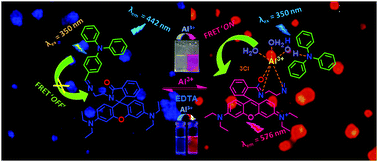FRET based ratiometric switch for selective sensing of Al3+ with bio-imaging in human peripheral blood mononuclear cells†
Abstract
In this work, a triphenylamine and rhodamine-B (donor–acceptor) hybrid switch (TPRH) was rationally designed, synthesised and characterised as a novel fluorescence resonance energy transfer (FRET) ratiometric fluorescent chemosensor for specific sensing of Al3+ over other important metal ions in mixed aqueous solution. We proposed that the sensor in hand (TPRH) is non-toxic and can be successfully employed to detect the Al3+ ion in human peripheral blood mononuclear cells (PBMCs), showing intracellular ‘FRET-ON’ mechanism. The orientation of the probe was designed in such a way that the fluorescence (or Förster) resonance energy transfer (FRET) proceeded from the ‘donor moiety’ triphenylamine to the ‘accepter moiety’ rhodamine-B. This fluorescent probe was found to be highly selective towards Al3+ over other important guest metal ions, including Fe3+ and Cr3+. Considering the adverse effects of Al3+ ions on human health and also on the environment, the development of sensitive and specific tools for the detection of Al3+ ions is of great value. The limit of detection (LOD) of TPRH was found to be in the order of 10−8 M. The TPRH–Al3+ complex showed reversible binding with demetallation in the presence of EDTA. In accordance with this reversibility, the fluorescence output at 576 nm from two active chemical inputs, namely, Al3+ and EDTA, followed a truth table of an INHIBIT logic gate. Moreover, cytotoxic studies found that the probe was safe to use in a biological system with good cell membrane permeability. More importantly, the bio-imaging of living human peripheral blood mononuclear cells (PBMCs) showed that TPRH could be used as an effective fluorescent probe for a prominent ratiometric in vitro detection of the transition trivalent metal ion Al3+. We evidenced a significant (p < 0.05) shift from blue to red fluorescence when Al3+ was added to the cell suspension, thus proving TPRH as a good candidate to detect intracellular Al3+.

- This article is part of the themed collection: New Journal of Chemistry Selected Articles in Physical and Materials Chemistry from India


 Please wait while we load your content...
Please wait while we load your content...